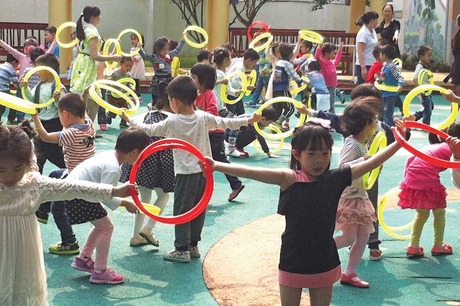
Take an assorted bunch of nursery proprietors, managers, heads, practitioners, advisory teachers, consultants and a magazine editor, put them in a room together and good conversation is guaranteed, despite their different perspectives on early childhood care and education.
Send them to China to look at the provision there and the talk never stops, not even after the steep climb up the Great Wall, on a walk through the Forbidden City, or a bike ride through paddy fields. The mix of famous sites and local early years settings on the Master Travel/Nursery World Early Years Education in China study tour offered a once-in-a-lifetime trip that will be the subject of conversation for a long time to come.

With the personable Chinese guide Zhang in charge (plus Boris the nursery bear), the group covered 4,000 miles within China and saw diverse early years settings, as well as a long list of tourist attractions including Tiananmen Square, the Forbidden City (now known as the Palace Museum), the Summer Palace, the Terracotta Warriors, the Great Wall of China and the panda in Beijing Zoo.

There were also many experiences not always available to the average tourist: the traditional Chinese medicine market; the backstreet calligrapher willing to write the names of British nurseries in beautiful Mandarin script; the canal ride in Suzhou with the boat captain's comedy routine as he sold his postcards and folding hats; the evening bike ride alongside the city walls of Xi'an, and the chance of an early morning tai chi session in the park.

But, most of all, we were privileged to be able to visit kindergartens, both private and state-owned, a nursery nurse training college, an after-school Baby Art 'hobby club' and an orphanage for abandoned children, many of whom had special needs and disabilities.
This was perhaps the most moving aspect of the trip for many of us, relieved at first that conditions were not as bad as they have been reported in the past, but still concerned to see that so many children are being abandoned, often because their parents cannot afford their medical bills.
The Xi'an orphanage, however, has developed an innovative scheme whereby foster carers live with their families in a building close to the orphanage and take home some of the children - who benefit from the specialist care provided by the orphanage during the day - to live with them in the evenings and at weekends.

The group spotted some similarities between early years provision here and in China, but the key difference has to be the fact that children do not enter primary school until they are six. The education director for Yangshuo County commented on the importance of this and the way that, although provision is tailored to meet the needs of children as they grow older during their kindergarten years, staff are adamant that children are too young for formal education until after six years old. There had been an unsuccessful attempt by government to lower the school starting age but, faced with pressure from the early years workforce, the idea was abandoned, as their specialist viewpoint on the issue was acknowledged.
Food for thought for us and an incentive to raise our own voices in the face of government pressures, perhaps?
It became clear during the visit that there is not the uniformity between settings in China that we might have supposed, but there were some common threads.
Whether state or private, all pre-school provision is fee-paying; the budget for state kindergartens is not enough to fully resource them, so parents are charged a nominal fee. Children are screened before admission and, as yet, there is little inclusion of children with special needs or disabilities, although there are some private settings that cater specifically for special needs. Settings all have access to health professionals, and children's health is monitored daily at the school gate - children showings signs of colds or other illnesses are sent home immediately.
The importance of play is acknowledged, but mostly through timed sessions of playing with games and so on. For example, one setting had an extensive block play room and art workshop that was used by classes in timetabled sessions.

Much emphasis is placed on music, art and craft, although the focus is more on the development of technique than creativity and personal expression. Nursery nurse training involves music (including piano playing) and art lessons as standard. A chain of after-school hobby clubs based in shopping malls provides play-based art tuition at the equivalent of £25 an hour for parents who can afford it. This seems very expensive even by UK standards, but indicates the high status that art is given by parents wanting their children to achieve.
Physical movement and exercise is given high priority, with regular morning sessions of 'music and movement'. These are joyful outdoor sessions with lots of noise and activity differentiated by age, using props as well as dance and martial arts moves.
These are just some of the aspects that the tour members are no doubt still processing as they look back through their many photos and hours of video footage of children and settings, and reflect on the privilege of being warmly welcomed into a professional world that is in many ways very different from our own, but with which we share a common belief in the importance of early childhood.

- For details of our second study trip to China (30 August to 13 September) and the Early Years Education in Finland and Sweden package (26-31 October), see www.mastertravel.co.uk/tours/professional-study-tours/educational-tours.
